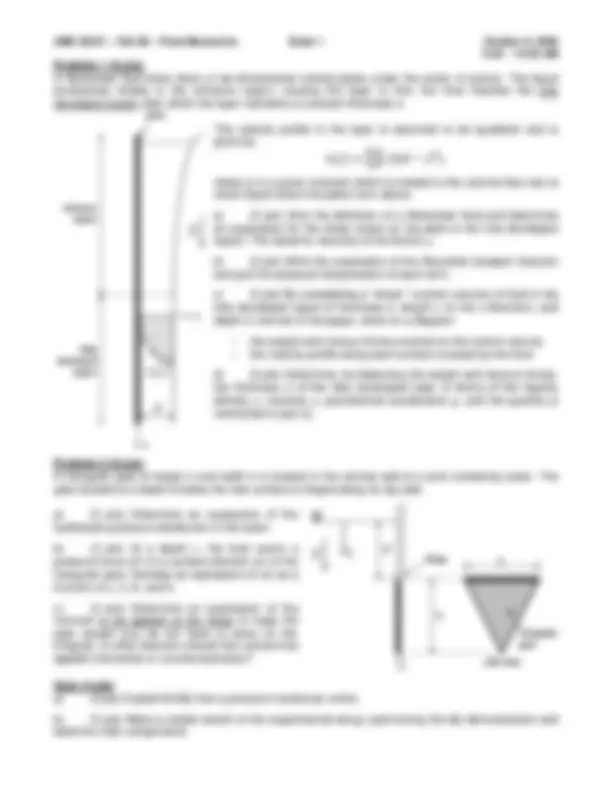



Study with the several resources on Docsity

Earn points by helping other students or get them with a premium plan


Prepare for your exams
Study with the several resources on Docsity

Earn points to download
Earn points by helping other students or get them with a premium plan
Community
Ask the community for help and clear up your study doubts
Discover the best universities in your country according to Docsity users
Free resources
Download our free guides on studying techniques, anxiety management strategies, and thesis advice from Docsity tutors
A past exam from a fluid mechanics course at the university of notre dame, fall 2008. The exam consists of 2 problems and a quiz. Students were not allowed to use books, notes, or calculators. The problems cover topics such as newtonian fluids, shear stress, reynolds transport theorem, hydrostatic pressure, and pressure forces on a triangular gate.
Typology: Exams
1 / 2

This page cannot be seen from the preview
Don't miss anything!


AME 30331 – Fall 08 – Fluid Mechanics Exam 1 October 6, 2008 9:35 – 10:25 AM
Name: _____________________________________ Format:
- This exam consists of 2 problems and 1 quiz.
Rules:
- The exam is closed book, closed notes. No calculator is permitted. - All assumptions must be justified to get the maximum number of points for each question. - Clearly indicate the final answer/result by drawing a box around it. - Use only 1 side of a standard letter size paper. - Begin each problem on a new page. - Place your name in the top, right-hand corner of each page. - Use only black/blue ink. - Staple your answer pages to this 2-page document.
Honor code: “As a member of the Notre Dame community, I will not participate in or tolerate academic dishonesty.”
Signature: _____________________________________
Problem 1 Problem 2 Quiz Total
Comments:
AME 30331 – Fall 08 – Fluid Mechanics Exam 1 October 6, 2008 9:35 – 10:25 AM Problem 1 (8 pts) A Newtonian fluid flows down a two-dimensional vertical plane under the action of gravity. The liquid accelerates initially in the entrance region, causing the layer to thin, but then reaches the fully developed region after which the layer maintains a constant thickness 𝑑.
The velocity profile in the layer is assumed to be quadratic and is given by:
3 2
𝑄
where 𝑄 is a given constant which is related to the volume flow rate at which liquid enters the plane from above.
a) (2 pts) Give the definition of a Newtonian fluid and determine an expression for the shear stress on the plate in the fully developed region. The dynamic viscosity of the fluid is 𝜇.
b) (2 pts) Write the expression of the Reynolds transport theorem and give the physical interpretation of each term.
c) (2 pts) By considering a “chunk” (control volume) of fluid in the fully developed region of thickness 𝑑, length 𝐿 (in the x-direction), and depth 𝐷 (normal to the page), show on a diagram:
- the weight and viscous forces exerted on the control volume - the velocity profile along each surface crossed by the fluid
d) (2 pts) Determine, by balancing the weight and viscous forces, the thickness 𝑑 of the fully developed layer in terms of the liquid’s density 𝜌, viscosity 𝜇, gravitational acceleration 𝑔, and the quantity 𝑄 mentioned in part a).
Problem 2 (8 pts) A triangular gate of height ℎ and width 𝑏 is located in the vertical wall of a tank containing water. The gate located at a depth 𝐻 below the free surface is hinged along its top side.
a) (2 pts) Determine an expression of the hydrostatic pressure distribution in the water.
b) (3 pts) At a depth 𝑧, the fluid exerts a pressure force 𝑑𝐹 on a surface element 𝑑𝐴 of the triangular gate. Develop an expression of 𝑑𝐴 as a function of 𝑧, ℎ, 𝐻, and 𝑏.
c) (3 pts) Determine an expression of the moment to be applied at the hinge to keep the gate closed (you do not have to solve for the integral). In what direction should this moment be applied (clockwise or counterclockwise)?
Quiz (4 pts) a) (2 pts) Explain briefly how a pressure transducer works.
b) (2 pts) Make a simple sketch of the experimental setup used during the lab demonstration and label the main components.